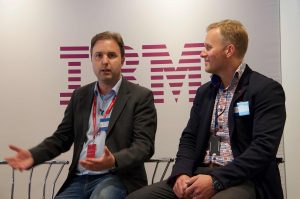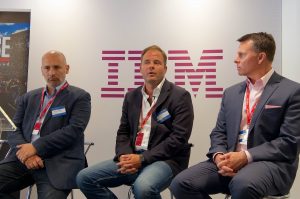Building on a firm Base: Spotting sporting opportunities in the cloud
A lot of companies offer services in the cloud, but not all of them can cope with the demands of broadcast, particularly sports, which requires a more considered approach.
This is according to specialist Base Media Cloud, which held a series of seminars (Racing to the cloud) in conjunction with IBM/Aspera and Wazee Digital and sporting organisations in London last week.
“There is so much choice in the market right now you can’t actually pick one tool, and if you do you are

Base ball: Damien Cullen of The Football Association, with Base Media Cloud’s Ben Foakes
locking yourself in to a workflow and you don’t have the agility to move and change to shape your business,” said Ben Foakes, MD and Founder, Base Media Cloud, which was formed three years ago and recently opened its second data centre.
Its concept is “to centralise the storage of your assets and then plug in whatever application you need on top,” to give clients “total choice”, from just backing up content automatically to file sharing globally. “We’re vendor agnostic, platform agnostic and network agnostic,” so that clients can pick and choose what is right for their business.
It won an IABM Design & Innovation Award for its work with Formula E in 2016, which was the first fully cloud-based delivery system for broadcast, although Foakes says it was a very simple system then, which has since become far more complex and sophisticated.
Electric avenue
Formula E is currently in its fourth season and uses a digital media hub “to deliver media very quickly, cost effectively, and by this new partnership with Base and Wazee, we have doubled the number of active users. We have gone from 90 to 220 [user organisations on board]. That’s a year-on-year growth,” and the design of the platform ensures speed and ease of use, said Adam Kemp, Broadcast and Distribution Manager, Formula E Holdings.

Electrifying: Adam Kemp of Formula E speaking at the ‘Racing to the cloud’ event in London
“We’ve also seen the number of downloads and of people using our content double,” he added. It has gone from 18.6m viewers per race in season three to 27.1m for season four (so far). He believes that wouldn’t have happened without all the changes it has made on the digital side. Because it has retained more of its rights, it’s been able to use more content online and now has more than 382m views of its digital content so far this season (compared to a total of 50m views for all of last season).
Formula E has specifically targeted a younger audience and initially wanted to be online only, but this wasn’t practical at the time, explained Ali Russell, its Director of Media and Business Development.
When looking for a cloud provider, ease of use was key, as it works with a large number of different channels, including many on YouTube (such as LADbible and Whistle Sports). “We wanted a platform that was resilient, that could help us build the awareness and be scalable. When we looked at partnerships, this was not the cheapest partnership we could have, but we thought it was one that we could grow with, that had solutions which were fit for our purposes at the time of our development, and also could grow and evolve and develop as we grew.”
Formula E does live clipping with Grabyo and tries to be first to get clips out. “It helps people to tune in to live. We think social is a really good tool to get people to remember there is a game on or there is a race on, and come and watch and be part of it,” he added.
However, it finds that younger viewers prefer streaming and VoD, “even with live sport,” said Russell, although he admits that some of that is due to the spread of time zones, and the fact that viewers are unlikely to see the result elsewhere because the sport still has a low profile, so it is still worth watching later.
Content for Formula E gets uploaded via Aspera to an IBM cloud, and Wazee Digital scans that content on its AWS cloud service, pulling the master up and creating transcodes, including previews, H.264 versions for digital distribution and ProRes masters for broadcasters.
“Once we’ve done that, all the content goes back to the IBM cloud, and Wazee Digital’s digital media

Waz up: Wazee Digital’s David Candler, with Formula E’s Ali Russell, and Mike Arthur of Wazee Digital
hub becomes the control, so you log in, you find your content, and you download,” from the IBM cloud rather than its Amazon S3 storage, explained David Candler, Senior Director, Customer Solutions, Wazee Digital, a proprietary software vendor that does content management and licensing as well as distribution, and all of its services are cloud based.
“On Aspera we’re processing about three Petabytes a year, and doing between 30,000 and 40,000 transcodes a day (because we have a footage licensing business as well), so we had to go to the cloud – it was the only place for us with the scalability,” which has helped on days when it has had to suddenly double the number of transcodes.
“Because we’re in the cloud we can work with other clouds and we can work with various web services and we need to,” added Candler, so a federation sponsored by Alibaba could use Alibaba’s cloud, thanks to its “open architecture and a very robust API.”
Wazee also ensures that users see only what they have the rights to, whether watermarked previews or full masters, and turns the traditional push model of sending out clips to users into a pull model where users have access to what they need.
Base tends to put content in one place, but is able to mount to all the different cloud services for different applications. For example, “you might be editing in AWS while you’re encoding in Azure and consuming AI services with Watson in IBM software,” said Damon Neale, CTO, Base Media Cloud. If the content is on multiple clouds, to take advantage of certain applications, the customer still uses the same user interface and it just looks like another folder.
Football focus
The Football Association’s FATV is also primarily focussed on using social channels (YouTube, Instagram, Twitter and Facebook) to engage with younger fans, offering inside-access content.
It has a centrally-based NAS that its team in Wembley work off, and every three months the material is deleted and shipped to the cloud. It has a team going to the World Cup, who will be able to access anything. “All they need is the bandwidth,” said Damien Cullen, Senior Video Manager, The Football Association. “How we edit and create is all cloud-based, so that people can do whatever they want wherever they want.”
It moved from an LTO-based system using a ProMAX Cache-A archive. “It took too long. It wasn’t robust enough. Things went missing,” he said. “It wasn’t working in a way where it was seamless and easy to use.” Because it took so long to get it protected in two places, this wasn’t done, which meant original source media got lost. This is why Base’s promise that he wouldn’t lose anything again was key to the FA’s move to the cloud.
Moving all the old material, on various formats, to the cloud involved a six-month migration, for which Base built the FA a mirrored private cloud, based in the UK, which Ben Foakes, Base Media Cloud’s MD and Founder, said is important for many of its clients, as they want to know exactly where their data is domiciled.
The system is designed to be automatic, with nightly uploads from the edit suites at Wembley. “No one has to touch anything, it happens in the background,” said Foakes.
This automation is vital, added Cullen, as: “We would ask people to back things up, and it would go to the bottom of the list, because they’ve other things to do.”

Cloud distribution: LCTV’s Laura Cotterill and Damon Neale of Base Media Cloud
“The difference between this workflow and mainstream backup,” explained Foakes, is that “mainstream backup is designed for small documents, virtual machines and traditional office IT. It’s not designed for media. You want to throw 10TB over a weekend at any mainstream backup service and it will just fall over,” while the FA’s system is accelerated and encrypted with unlimited bandwidth, and a big project finished on a Friday night will be safely archived when you return on Monday morning.
Cullen likes the added security of the cloud and its easy scalability. “When I started at the FA we were very locked in to an Avid/PC environment, and could only buy certain products, but because [the cloud] is scalable and agnostic I’ve got the choice to move as I see fit,” whether scaling up to 200TB or down, and allowing users access material from different platforms.
“If you wanted to design and build what we’ve done for the FA it would be over £1million,” said Foakes. “But, because it is a multi-tenanted shared environment, it is a way lower cost for us and therefore cheaper for the client.”
Overcoming a hideous start
Distributor LCTV specialises in sport, dealing mainly with broadcasters and airlines. “We have a lot of different people uploading content,” and “I think we’ve tested the guys at Base Media,” said its Founder and MD, Laura Cotterill.
When LCTV first went digital, five years ago, it gave broadcasters a choice of formats, “but it was far more costly, far more complicated,” so it now only offers one way of getting material.
It moved to Base, on the advice of Formula E, after “two fairly tumultuous years of working with American digital companies, who were really keen to get the business, and then they realised that what we did wasn’t quite as straightforward as they thought,” she said. “Those two years were fairly hideous, because it takes a long time to set this up and feel that everybody is comfortable with it, not just us, but them as well because these guys are doing the ingesting, the transcoding.”
LCTV “receives content from loads of different places, in a lot of different formats, everyone’s used to using different tools, with a different level of media understanding and technical expertise,” said Neale.
The system allows access on a self-service basis, which would usually require some level of technical expertise, so Base tried to make it as simple as possible. “You drop it in a folder. It will create the format you need. It is very much just drag and drop,” he said. “It’s the only way to handle this many people delivering content. It has to be automated.”
The biggest difficulty dealing with so many formats is trying to create a simple workflow to deal with it, which can mean having to force people down a certain route, to a certain format, “but there’s always the case where people are delivering the wrong format or want to use a different tool,” for which it uses a really simple tool from Aspera for uploading and to allow LCTV monitor and check it. It then scans the file metadata to see what it is and if it conforms to what it is meant to be, and if it is, it is moved straight to a delivery folder, otherwise it can inform LCTV that the format is wrong so they can contact the uploader, or can automatically re-encode it.
Neale has worked on cloud systems for companies previously, where the project took two years, cost millions of pounds, and required considerable expertise in servers, storage and networks, and then you need to do licence deals for the appropriate software. Then you have to support it and manage it.
“There is so much lead time, cost and expertise required to do it, and on top of that it is very inflexible.” If it is designed for the needs of today, it might not be suited to how your business changes, whereas with the cloud, the initial costs are so much lower, and it can easily be added to in various ways to cope with any changes.
“It enables us to get on with what we do, which is the distribution to [80+] TV networks and [20] airlines, and we did look at hosting this and building this ourselves,” said Cotterill. She knows several small distribution companies who do this themselves, “but they are stuffed the minute that there is a new system or methodology; they are stuck with their old ones, and it’s not cheap to do.”
